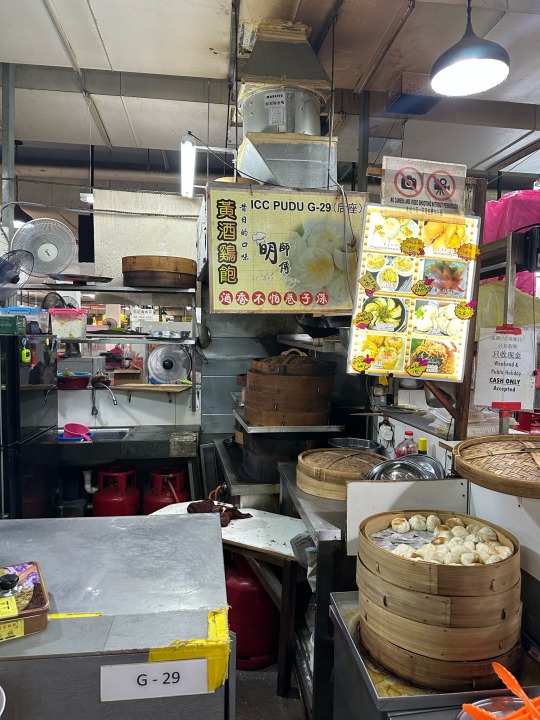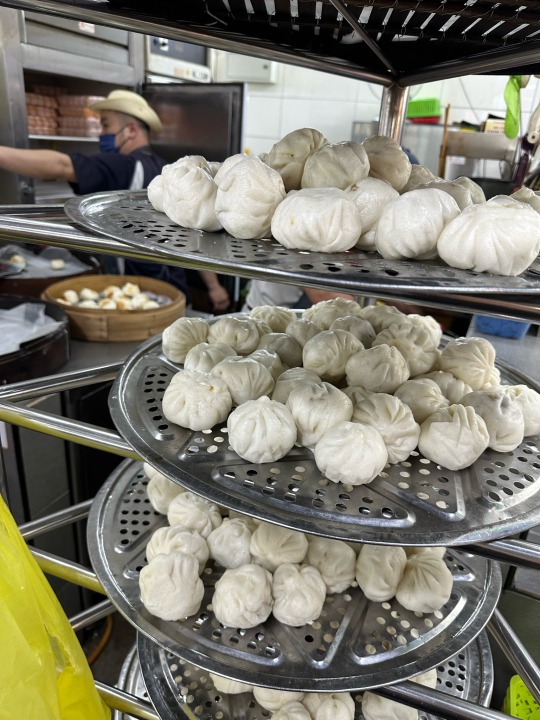#Rice wine
Explore tagged Tumblr posts
Text

One batch of Swedified Frankensake coming up! 😁
Just getting ready to start on another weird batch. I had been wanting to try a Thai black rice and blueberry brew mainly for the color, but the pressure cooker I've been using as a rice cooker for glutinous rice is messed up and we haven't fixed or replaced it yet. And I really didn't want to mess with steaming wholegrain rice over a pot of water on the stove.
But, I have also been thinking of trying something with oats for a cheaper brew using at least mostly local ingredients. (Also want to try growing my own koji on oats, but not right now.) Apparently at least one other person had luck with a combo oat and rice wine: Has anyone else experimented with oats? Just bottled a 45/55 oat/rice micro-batch. It’s silky smooth.
May as well try combining the two experiments!
So, I decided to try basically adapting the corny batch recipe to start off with cooked oatmeal instead of cornmeal mush (or rice porridge) partly because it's cheaper than the other oats. Also scaling this batch down some, on the chance it turns into a real shitshow.
We've also got that wholegrain oat "rice", which I think is actually steamed or something to make it cook faster. It does cook up just about like white rice. Sort of hedging my bets with that jasmine rice. I know it works fine for part of a batch with the pricier glutinous rice, and we accidentally bought boil in bag stuff which is handily premeasured out at 125g a bag. Couldn't hurt, and I'm just planning to cook them together in the same pot. They're close enough on cooking time and water ratios that it should hopefully work OK.
I guess half that bag of berries can get thawed and thrown in when I add the whole oats and rice after a couple days.

Will this turn out drinkable? That's anybody's guess. Should it be fun to try? Hells to the yeah.
18 notes
·
View notes
Text



[We put the garlic and the rice wine. Here comes fire. "Here comes fire."]
6 notes
·
View notes
Text

5 notes
·
View notes
Text

#bts jhope#bts suga#jung hoseok#min yoongi#kpop idols#hanbok#moju#rice wine#traditional#cute guys#jhope#suga#yoongi#j hope#bts#bangtan#drinking#double trouble#kpop boys
15 notes
·
View notes
Text

Niu Rou Mian (Beef Noodle Soup)
3-4 lbs beef shanks (Preferably with the bone and marrow still attached to make for a richer stock, or separated by tendons. If it is separated by tendons, the meat will have to be sliced before serving)
1 can chicken broth
1 yellow onion
1 tomato
soy sauce
shaoxing wine (rice cooking wine)
rock sugar (the best is the "red" kind from Taiwan)
spices (I use a special packet of spices I bring back from Taiwan, but star anise would work fine)
dou ban jian (hot chili bean paste)
noodles (I actually use a dry flour kind from Nijiya Market)
scallions
cilantro
Place the beef shanks in a pot of water and bring to a boil. This prevents the impurities in the beef from getting into your stock later. Remove the beef shanks and place in a clean pot.
Add one can of chicken broth (family secret!) and add enough additional water to cover the beef.
Cut both the tomato and onion in half before adding to the pot.
Add soy sauce, shaoxing wine, rock sugar, and spices in ratios that work for you. The best way to do this is to taste test. To get more flavor into the meat, don't be afraid to add a good amount of soy sauce. I like to thin this braising liquid with more chicken broth or water at the end to make the stock. If you want some spiciness in your stock, add some dou ban jian to taste. I grew up without it, but I think it adds a flavor that many associate with niu rou mian.
Bring to a boil and let simmer for at least 2 hour, or until tender. The meat will harden when cooled, so keep that in mind.
Before serving, cook noodles, reheat the stock, and slice the beef. Combine and garnish with cilantro and green onions.
#angelkin#food#lunch#dinner#soup#dairy free#meat#beef#chicken#vegetable#onion#tomato#soy#rice wine#rock sugar#anise#doubanjiang#noodles#scallion#cilantro#dogkin#dragonkin#faekin#kitsunekin#merkin#pantherkin#phoenixkin#Summer#winter
16 notes
·
View notes
Text

🇯🇵 🍷 I'm not a sake expert, but this Shunka Shusetsu Echizen Junmai Ginjo Sake (91 pts, $30) from Japan is lovely! Arrived in LCBO VINTAGES in January and still available. Full review: https://rebrand.ly/hgxgyx1
#wine#rice wine#sake#junmai ginjo#japan#wiyg#winelover#wineoclock#wine wednesday#wednesday night#lcbo
4 notes
·
View notes
Text
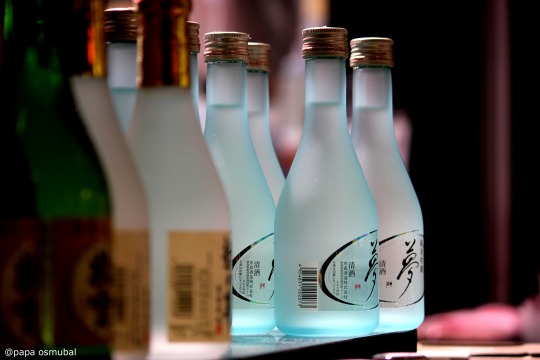
Sake rice wine
5 notes
·
View notes
Text





#sake#Japanese#Rice Wine#Anime#Manga#Attack on Titan#eren jaeger#mikasa aot#pnw#wa#green coast livin#corxandforx#aot
5 notes
·
View notes
Text
Rice wine update, like 21 hours in:
There was already a visible liquid layer starting to separate out when I got up this afternoon, and the yeast is bubbling merrily away. It's been staying somewhere around 25C/77F in here, but this still seems pretty quick even so.
Earlier I did stir at it, and mixed in a low guesstimated amount of yeast nutrients because it seemed like a good idea with this too. Idk, I'm calling that batch a liter of liquid all told. ¯\_(ツ)_/¯ Don't want to maybe overdose and give it a weird taste.
Didn't take long for the rice mush to separate right back out like that again after the mixing, and get more gas pockets from the yeast. For now, planning to give the stuff a daily stir, and probably dip out a little spoonful of the liquid to taste test starting after 3 or 4 days. Judging by what people with more experience seem to be doing, and the fact that this batch has been working so fast in even Swedish summer weather. Also give a better idea of how the brew is developing.
For now, it smelled sweet and surprisingly fruity when I had the lid open. You could eat it as an amazake/jiuniang type thing at this point. I'm just basically going for a "turn it alcoholic" speedrun with the added yeast. But, the way this was smelling, I can see why it might make an appealing sweet treat.
20 notes
·
View notes
Text



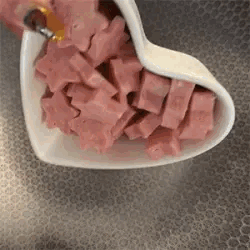

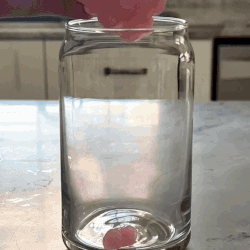

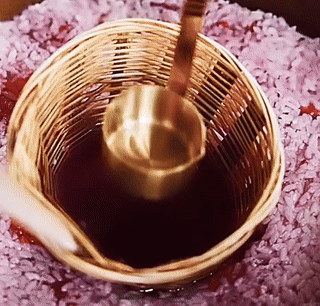


Stimboard Challenge #7: Special Interest (Version 1: Cooking)
🩷🍣🩷
🍥🩷🍥
🩷🍣🩷
🩷🍣🍥Trim🍥🍣🩷
#stimboard challenge#stimboard#stim board#c0smiccreature stimboard challenge#pink#pink aesthetic#cooking#wine making#marshmallow#pink drink#food#pink food#pink gif#gif set#gifset#gifs#rice#rice wine#poke bowl
5 notes
·
View notes
Text
Kung Pao Tofu
Via NYT Cooking. Yield: 3 to 4 servings 1 (14-ounce) package extra-firm tofu ¼ cup soy sauce 2 tablespoons brown sugar 2 tablespoons hoisin sauce 2 tablespoons rice wine or sake 1 tablespoon black vinegar (or rice wine vinegar) 2 teaspoons toasted sesame oil ½ teaspoon freshly ground white pepper or ¼ teaspoon finely ground white pepper 3 garlic cloves, finely grated 1 (1-inch) piece…
#arbol chiles#bell pepper#black vinegar#brown sugar#celery#cilantro#cornstarch#hoisin#meals#peanuts#rice wine#scallion#sesame oil#sichuan peppercorns#soy sauce#Tofu#vegetarian
0 notes
Text
Explore the growing rice wine market, driven by cultural significance, probiotic benefits, and opportunities in premium flavors and global expansion.
#Rice Wine Market#Rice Wine#Rice Wine Market Size#Rice Wine Market Share#Rice Wine Market Growth#Rice Wine Market Trends#Rice Wine Market Forecast#Rice Wine Market Analysis#Rice Wine Market Report#Rice Wine Market Scope#Rice Wine Market Overview#Rice Wine Market Outlook#Rice Wine Market Drivers#Rice Wine Companies
0 notes
Text

Yesterday got a big rainy, I really want to eat korean pancake and rice wine. It’s tasty so good, rainy vibe is so calm and sound is so good. But when the get rain, I really don’t like go outside. Rain is just sound good.
0 notes
Text
Sweet and sour pork recipe - The GialloZafferano recipe
Sweet and sour pork recipe – The GialloZafferano recipe One of the fundamental criteria of Chinese cuisine it is the harmonious balance of colors, flavors and textures. Sweet and sour pork is a traditional recipe that perfectly represents this characteristic, starting from the choice of ingredients: the green of the peppers, the red of the tomato and the yellow of the pineapple, a brightly…
#00 flour#Black pepper#cooked#Copper tomatoes#egg#Green peppers#Instant yeast for savory preparations#It goes up fine#kitchen#Pig#Pineapple in syrup#Potato starch#recipe#Recipes#Rice wine#sugar#Sunflower seed oil#Sweet and sour pork#Tomato concentrate#Waterfall#White wine vinegar
0 notes
